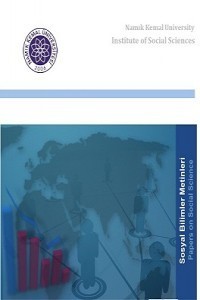Does Central Bank Of Republic Of TURKEY React To Asset Prices?
The last decade made many Central Bankers dry and single minded inflation targeting bodies or at least they acted as if they were just targeting inflation. However, some speeches of the Central Bankers or some econometric analyses about Central Bank behaviors show different intentions. This paper analyses last ten years or the inflation targeting years of CBRT and tries two answer two critical questions: Does CBRT react to asset prices and if it does, is this reaction asymmetrically biased? A Taylor Rule like inflation targeting rule is used to regress Central Bank’s policy tool interest rate with inflation deviation, output gap and a self created Asset Price Index. The econometric analysis below shows that the answer to both of the questions above is positive in this context.
Anahtar Kelimeler:
Central Bank Policy, Asymmetric Behavior, Asset Booms, Housing Bubble, GMM
___
- Bernanke, B. & Gertler M.(1999). Monetary policy and asset prices volatility. Federal Reserve Bank of Kansas City Economic Review, 84(4), 17-51. Bernanke, Ben, and Mark Gertler (2001). Should Central Banks Respond to Movements in Asset Prices? American Economic Review, May, 253–7. Cecchetti, S., H. Genberg H., J. Lipsky J. & Wadhwani S.(2000). Asset Prices and Central Bank Policy. CEPR, London. Cecchetti, Stephen G., Hans Genberg and Sushil Wadhwani (2002). Asset Prices in a Flexible Inflation Targeting Framework. NBER Working Paper No. 8970, June. Clarida, R., Gali, J. & Gertler, M. (1998) Monetary policy rules in practice. European Economic Review, 42, 1033–67. Filardo, A.J. (2005). Should Monetary Authorities Prick Asset Price Bubbles? Unpublished paper, March, BIS. Gerlach, S. & Schnabel, G. (2000) The Taylor rule and interest rates in the EMU area, Economics Letters, 67, 165–71. Greenspan, A. (2003), ‘Monetary Policy under Uncertainty’, Speech before Symposium sponsored by the Federal Reserve Bank of Kansas City, Jackson Hole, WY, 29 August. Mishkin, F.(2007). “Housing and the Monetary Transmission Mechanism.” Finance and Economics Discussion Series, Federal Reserve Board, August. Mishkin, F.S. (2008). How Should We Respond to Asset Price Bubbles? Speech at the Wharton Financial Institutions Center and Oliver Wyman Institute's Annual Financial Risk Roundtable, Philadelphia, Pennsylvania. Reaching adress: http://www.federalreserve.gov/newsevents/speech/mishkin20080515a.htm. Naraidoo R. & Kasai N. Financial asset prices, linear and nonlinear policy rules. An In-sample assessment of the reaction function of the South African Reserve Bank. Working paper No 2010-06, Department of Economics, University of Pretoria. Papademos, L. (2009). Monetary policy and the ‘Great Crisis’: Lessons and challenges. Speech at the 37th Economics Conference “Beyond the Crisis: Economic Policy in a New Macroeconomic Environment” organised by the Österreichische Nationalbank, Vienna, 14 May 2009. Available from: http://www.ecb.int/press/key/date/2009/html/sp090514.en.html. Roubini N. (2006) Why Central Banks Should Burst Bubbles. International Finance 9:1, 87–107. Taylor, J. (1993) Discretion versus policy rules in practice, Carnegie-Rochester Conference on Public Policy, 39, 195–214
- ISSN: 1308–4453/1308–4895
- Yayın Aralığı: Yılda 2 Sayı
- Başlangıç: 2008
